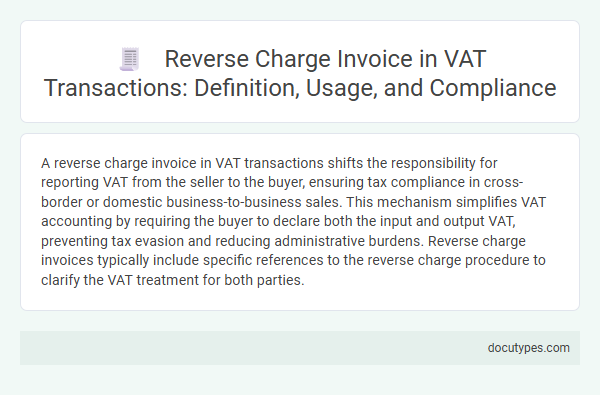A reverse charge invoice in VAT transactions shifts the responsibility for reporting VAT from the seller to the buyer, ensuring tax compliance in cross-border or domestic business-to-business sales. This mechanism simplifies VAT accounting by requiring the buyer to declare both the input and output VAT, preventing tax evasion and reducing administrative burdens. Reverse charge invoices typically include specific references to the reverse charge procedure to clarify the VAT treatment for both parties.
Introduction to Reverse Charge Invoice in VAT
| Topic | Description |
|---|---|
| Definition | A reverse charge invoice is a VAT mechanism where the responsibility to report VAT shifts from the supplier to the customer. |
| Purpose | It prevents tax evasion and simplifies VAT collection in cross-border or specific domestic transactions. |
| Application | Used mainly in business-to-business (B2B) transactions involving goods and services subject to VAT regulations. |
| Your Role | When you receive a reverse charge invoice, you must account for VAT as both supplier and recipient in your VAT return. |
| Key Detail | The invoice should clearly state that the reverse charge mechanism applies, including relevant legal references. |
Definition of Reverse Charge Mechanism
A Reverse Charge Invoice in VAT transactions refers to a billing process where the buyer, instead of the supplier, is responsible for reporting and paying the Value Added Tax. This mechanism shifts the tax liability from the seller to the purchaser, commonly used in cross-border services and goods within VAT systems. The reverse charge simplifies tax compliance and reduces VAT fraud in international trade.
Key Features of Reverse Charge Invoice
A reverse charge invoice shifts the VAT payment responsibility from the seller to the buyer in VAT transactions. This mechanism helps simplify tax collection and prevent fraud in cross-border sales.
- VAT Liability Transfer - The buyer accounts for and pays the VAT instead of the supplier, ensuring compliance in certain transactions.
- Invoice Requirements - The invoice must clearly state that the reverse charge applies and include all necessary tax details for audit purposes.
- Applicable Transactions - Commonly used in international services, goods importation, and specific domestic supplies to streamline VAT reporting.
Scenarios Requiring Reverse Charge Invoice
A reverse charge invoice is a VAT mechanism where the responsibility to account for VAT shifts from the supplier to the recipient. This system simplifies tax collection and combats VAT fraud in cross-border and specific domestic transactions.
Scenarios requiring a reverse charge invoice include international trade within the European Union, where the buyer reports both input and output VAT. Domestic transactions involving services like construction, telecommunications, and supply of goods by unregistered dealers also mandate reverse charge invoicing.
Usage of Reverse Charge Invoice in Domestic Transactions
What is a reverse charge invoice in VAT transactions? A reverse charge invoice shifts the responsibility of VAT payment from the supplier to the buyer, simplifying tax compliance. This mechanism is commonly applied in domestic transactions to prevent VAT evasion and streamline tax collection.
How is a reverse charge invoice used in domestic transactions? You use a reverse charge invoice when purchasing certain services or goods from suppliers within your country, where the buyer must declare and pay the VAT instead of the seller. This approach ensures accurate VAT reporting and avoids double taxation in domestic trade.
Cross-Border Transactions and Reverse Charge
A reverse charge invoice is a critical document in VAT transactions, especially within cross-border trade. It shifts the VAT payment responsibility from the supplier to the recipient, simplifying tax compliance across different tax jurisdictions.
- Cross-Border Transactions - These transactions often involve goods or services supplied between businesses in different countries, requiring special VAT treatment to avoid double taxation.
- Reverse Charge Mechanism - This mechanism ensures the buyer accounts for VAT instead of the seller, streamlining VAT reporting and collection in international trade.
- Invoice Requirements - A reverse charge invoice must clearly state that the reverse charge applies and include the buyer's VAT number to validate the transaction for tax authorities.
You must ensure your invoices comply with reverse charge rules to maintain proper VAT accounting in cross-border transactions.
Compliance Requirements for Reverse Charge Invoice
A Reverse Charge Invoice in VAT transactions shifts the responsibility for VAT payment from the supplier to the recipient. This mechanism is crucial for cross-border services and certain domestic supplies to prevent VAT fraud and simplify tax collection.
Compliance requirements for a Reverse Charge Invoice include clearly stating that the reverse charge applies and indicating the VAT amount is to be accounted for by the recipient. You must include the supplier's and recipient's VAT identification numbers and reference the applicable reverse charge legislation. Ensuring accuracy in these details supports proper VAT reporting and avoids penalties during audits.
Correct Issuance and Record-Keeping Practices
A reverse charge invoice is a critical document in VAT transactions where the responsibility to pay VAT shifts from the supplier to the buyer. Accurate issuance and meticulous record-keeping of these invoices ensure compliance with tax regulations and prevent fiscal discrepancies.
Correct issuance involves explicitly stating the reverse charge mechanism on the invoice and including all mandatory details such as VAT numbers and transaction descriptions.
- Clear Identification - The invoice must prominently display a reverse charge statement to inform both parties of the VAT payment shift.
- Accurate Data Entry - Include precise supplier and buyer VAT registration numbers along with transaction values without VAT included.
- Comprehensive Record-Keeping - Maintain detailed records of all reverse charge invoices for audit purposes and reconciliations.
Common Errors and Audit Risks
A reverse charge invoice in VAT transactions shifts the tax liability from the supplier to the customer, typically used in cross-border or domestic services. Common errors include incorrect VAT rates, missing supplier or recipient details, and failure to apply the reverse charge mechanism properly. These mistakes increase audit risks, potentially leading to penalties, VAT assessments, and disrupted cash flow for businesses.
What Is a Reverse Charge Invoice in VAT Transactions? Infographic

